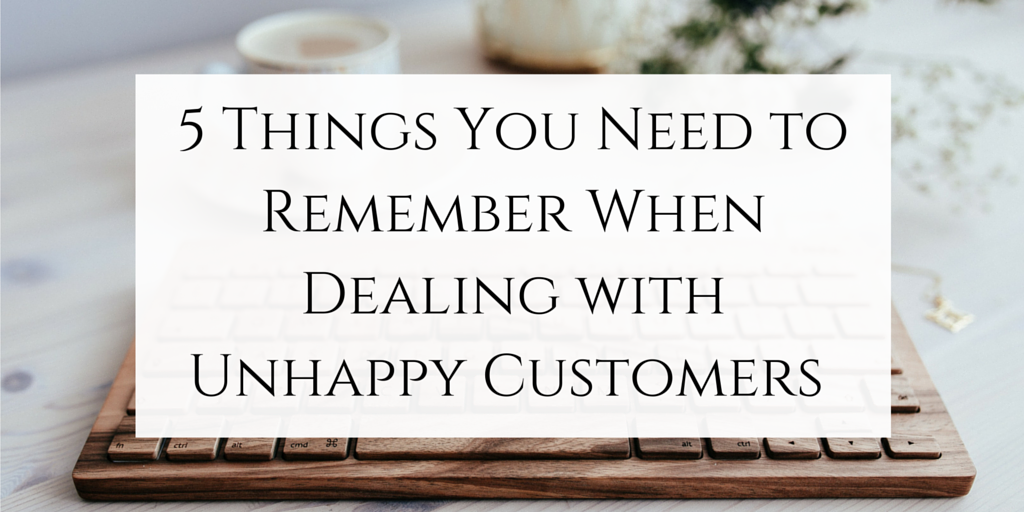To continue our series on creating an online home for your business, I wanted to tackle one of the trickiest (and most annoying) subjects for small business owners: customers service in the online world.
In some ways, customer service is really straightforward, right? You do your best to provide quality products or stellar services, you deliver on your promises, you treat your clients respectfully.
But in other ways, customer service is terrible. And in my opinion, that’s because of the internet.
The internet makes people:
- act rude and angry because they can’t see you
- respond without actually reading the email you sent
- forget that there is such a thing as business hours
- expect that everything will cost $5
- share every thought as soon as they think it
The internet makes people demanding. It makes them expect more for less. It makes them forget that you are an actual person with a life and feelings.
We’ve all been there, right? The thoughtless comments on social media. The angry email you send when the shoes you ordered still haven’t arrived a month later. The time you looked at a handmade, hand-painted, small-batch, ethically-produced set of coffee mugs and thought, “Pssh, I can basically find those on [your favorite internet discount store] for $1 each, why would I ever pay that much PLUS SHIPPING?”
But when it’s all directed at you, it seems so. much. worse, right?
When you’re the one on the receiving end of bad customer behavior, when someone is unhappy with or insulting not just the business you poured your heart and soul into, but you, what do you do? How do you respond?
1. Step away from the computer
You already know to do this, right?
When you get an irate email or an angry message through your website, take your hand off the keyboard and step away.
Yes, you want to respond quickly and resolve the situation. Yes, you want to defend yourself and your business and your products.
But responding to a complaint when you are in the middle of a full-blown emotional maelstrom is never going to do you any good. Write out your angry, defensive response by hand if you need to, but don’t put it in an email. Instead, wait however long it takes for you to feel calm again (a couple minutes or a couple hours) and then draft a courteous, professional response. If you can, ask a colleague or friend to read it over and make sure that the tone and language aren’t going to escalate the situation.
2. Help your customers understand your value
You charge what you’re worth. You take pride in your products for a reason. You offer a value that no one else has.
The way you present your company should help people understand what that value is and why it’s worth paying for.
Yes, in the online world, there is always someone offering a similar product or service for less money. So why should customers buy from you?
You may offer specialized experience. Handmade quality. Ethical business practices. A personal connection. Legions of satisfied customers who can attest to your skills. Whatever it is that sets you apart, show that on your website, your FAQ page, your social media accounts. Help clients understand what makes your business worthwhile, and they’ll be more likely to understand your prices and processes.
3. Take responsibility when you can
No, it was not your fault that the post office mis-delivered the product your customer ordered.
But guess what? It’s still your job to make it right because the post office sure as heck isn’t going to.
Part of being a business owner is not passing the buck. So if your customer is unhappy with something, acknowledge their complaint and apologize. If there was a misunderstanding or a miscommunication, explain how it came about. Offer a redo or to send a new product. Give them a discount for free shipping on their next order.
Do what you can to fix the situation, because the last thing you want is for the situation to escalate (especially if escalation means public complaints or bad reviews).
4. Set respectful boundaries
I’ll admit, it took me a long time to do this one. When you run your own business, you want to always be available to anyone who needs you and any opportunity that comes along.
But that client email that comes in at 11pm on a Tuesday?
The project that seems to expand in scope every time you open your inbox? The client who says you “don’t need” a contract? Those require some boundaries.
It’s okay to say no to things that make you uncomfortable or infringe on your personal life.
You are entitled to the boundaries that make you feel comfortable and productive. It’s okay to explain those, respectfully, when someone is stepping over them. And if they continue to step anyway? You can politely remove yourself from the situation with by saying no thank you and offering to refer them to a different business that will be a better fit.
5. Try not to take it personally
I once had a client order several blog posts from me. Two of them went over well. The third one was not what the client expected, but instead of just asking for a rewrite, he sent a long, angry email that accused me of trying to sabotage his business.
Did I freak out? Absolutely. Did I get angry and cry to my husband and draft a furious email in response? 100% accurate.
But did I respond politely and offer a rewrite and end the day with a happy client? You bet.
People lash out, especially online, especially against a small business that seems like an easy punching bag. But it’s important to remember that most of the time, how they act is not actually about you.
It’s about the customer who lashed out at them yesterday. It’s about the driver who cut them off on the way to work today. It’s about the stress of raising a teenager or the trouble they had sleeping last night or the fact that they left their phone on the subway that morning.
In other words, it’s not personal.
Does it feel personal? Absolutely. This is your inbox, your business, your livelihood. This is your work that’s being attacked or demeaned or devalued. But the person on the other end of that angry email isn’t thinking of you as a person right at that moment.
That stinks, but it’s also liberating, because it means all you have to do is make their life feel easier again and they’ll be satisfied. Respond with professional courtesy. Apologize for any inconvenience. Do your best to make it better. Nine times out of ten, you’ll end the day with a satisfied customer.
And then go punch a pillow and complain to your friends over a glass of wine. Because you deserve to feel better too.
Have you had any customer service snafus in the online world? How did you handle them?
PS – 4 ways to impress your clients and help your business + 8 guidelines to follow to work from home successfully


Leave a Reply